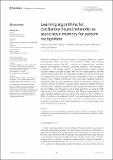Por favor, use este identificador para citar o enlazar a este item:
http://hdl.handle.net/10261/342081COMPARTIR / EXPORTAR:
 SHARE SHARE
 CORE
BASE CORE
BASE
|
|
| Visualizar otros formatos: MARC | Dublin Core | RDF | ORE | MODS | METS | DIDL | DATACITE | |

| Título: | Learning algorithms for oscillatory neural networks as associative memory for pattern recognition |
Autor: | Jiménez Través, Manuel CSIC ORCID ; Avedillo, María J. CSIC ORCID; Linares-Barranco, Bernabé CSIC ORCID; Núñez, Juan CSIC ORCID | Palabras clave: | Phase-change material Associative memory Character recognition Hopfield neural networks Machine learning algorithms Oscillators Oscillatory neural networks (ONNs) Pattern recognition |
Fecha de publicación: | 29-nov-2023 | Editor: | Frontiers Media | Citación: | Frontiers in Neuroscience 17: 1257611 (2023) | Resumen: | Alternative paradigms to the von Neumann computing scheme are currently arousing huge interest. Oscillatory neural networks (ONNs) using emerging phase-change materials like VO2 constitute an energy-efficient, massively parallel, brain-inspired, in-memory computing approach. The encoding of information in the phase pattern of frequency-locked, weakly coupled oscillators makes it possible to exploit their rich non-linear dynamics and their synchronization phenomena for computing. A single fully connected ONN layer can implement an auto-associative memory comparable to that of a Hopfield network, hence Hebbian learning rule is the most widely adopted method for configuring ONNs for such applications, despite its well-known limitations. An extensive amount of literature is available about learning in Hopfield networks, with information regarding many different learning algorithms that perform better than the Hebbian rule. However, not all of these algorithms are useful for ONN training due to the constraints imposed by their physical implementation. This paper evaluates different learning methods with respect to their suitability for ONNs. It proposes a new approach, which is compared against previous works. The proposed method has been shown to produce competitive results in terms of pattern recognition accuracy with reduced precision in synaptic weights, and to be suitable for online learning. | Versión del editor: | https://doi.org/10.3389/fnins.2023.1257611 | URI: | http://hdl.handle.net/10261/342081 | DOI: | 10.3389/fnins.2023.1257611 | ISSN: | 1662-4548 | E-ISSN: | 1662-453X |
| Aparece en las colecciones: | (IMSE-CNM) Artículos |
Ficheros en este ítem:
| Fichero | Descripción | Tamaño | Formato | |
|---|---|---|---|---|
| pattern-recognition.pdf | 4,67 MB | Adobe PDF |  Visualizar/Abrir |
CORE Recommender
Page view(s)
41
checked on 18-may-2024
Download(s)
19
checked on 18-may-2024
Google ScholarTM
Check
Altmetric
Altmetric
Este item está licenciado bajo una Licencia Creative Commons

